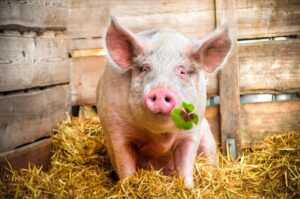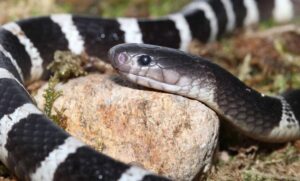In the world of snakes, there are many different species with varying characteristics in terms of their appearance, venom, size, and especially their color. If you’d like to know more about what Yellow Snakes are and what some of the most distinctive yellow species are, then we invite you to read the following article from KnowAllAnimals to find your answers.
1. What Are Yellow Snakes?
Yellow snakes can belong to many different species, so it’s impossible to accurately identify a type of snake based solely on its color. However, we can provide some general information about a few common species of yellow snakes that are currently distributed around the world.
There are many yellow snake species that are non-venomous, such as the Garter Snake and the Grass Snake. They usually have a pale or brownish-yellow color and pose no danger to humans. However, their striking yellow color often leads people to mistakenly believe they are venomous. This is because people generally believe that colorful, vibrant reptiles are often very poisonous, and the same goes for yellow snakes.
However, there are also some yellow snake species that can be very venomous. But judging a snake based on color alone is not entirely accurate and can be dangerous for people. Some venomous yellow snakes may include the King Cobra and the Russell’s Viper. These species have potent venom and can be life-threatening.
Therefore, to accurately determine whether a yellow snake is venomous, you need to identify detailed information about its appearance, size, habitat, behavior, and species. This is a job for experts or people with experience and knowledge of snakes. For ordinary people, it’s best to stay away from any snake you encounter. If you leave them alone, they will not attack or pose a danger to you.
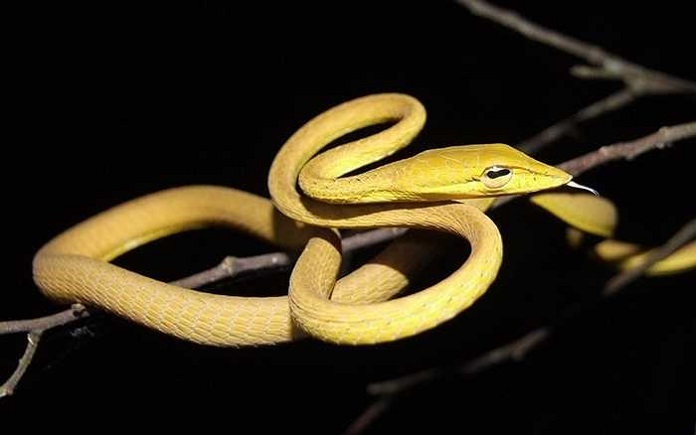
2. Top 8 Most Beautiful Yellow Snakes in the World
To give you more information and knowledge about yellow snake species, here is a list of the most popular yellow snakes today.
2.1. Eastern Garter Snake (Thamnophis sirtalis)
The Eastern Garter Snake (Thamnophis sirtalis) is a small, common snake that is widely distributed in North America. Here’s some detailed information about this species:
Appearance: The Eastern Garter Snake has an average length of 46–137 cm (18–54 inches), depending on the individual and geographic region. They have slender, flattened bodies and small heads. Their colors can vary, but most have a dominant yellow color and may have dark stripes or markings that run along their bodies. This coloring helps them blend in with their surroundings.
Distribution and Habitat: Eastern Garter Snakes are distributed throughout North America, from southern Canada to Mexico. They live in diverse environments such as fields, gardens, grasslands, forests, and meadows. Garter snakes like to hide in the grass or under natural materials like rocks or wood.
Behavior and Diet: Eastern Garter Snakes are non-venomous and are generally not a danger to humans. They mainly hunt small animals like frogs, mice, worms, and insects. Garter snakes prefer to hide and may respond by biting or acting threatening if they feel cornered.
Reproduction: Eastern Garter Snakes are live-bearing snakes. The female will give birth to 10–40 young in the spring or summer. The young are born in a sac and will hatch after a few hours to a few weeks.
The Eastern Garter Snake is a common and beneficial snake that helps control the overpopulation of pests like insects and mice. Although they may bite when they feel threatened, Garter Snakes are non-venomous, so they are not a danger to human life.

References: https://en.wikipedia.org/wiki/Eastern_garter_snake
2.2. Banded Krait (Bungarus fasciatus)
The Banded Krait (Bungarus fasciatus) is a venomous snake that belongs to the family Elapidae. Here is some information about this species:
Appearance: The Banded Krait has an average length of 1.2–1.5 meters (4–5 feet), but can reach up to 2 meters. They have a flattened, tubular body, a small tail, and a triangular head. The color of a banded krait is typically black or dark brown with distinct white or yellow stripes on its body.
Distribution and Habitat: Banded Kraits are widely distributed throughout Asia, including India, China, Southeast Asia, and Indonesia. They like to live in diverse environments such as forests, fields, grasslands, and areas near rivers and lakes.
Behavioral Characteristics: The Banded Krait is a venomous snake with potent venom. They have a fixed front jaw and two short, rigid fangs at the front of their upper jaw. Banded kraits are typically active at night and have a solitary habit. They hunt by lying in wait and attacking their prey by surprise when it gets close. They mainly eat small animals like mice, rabbits, and other snakes.
Conservation Status: The Banded Krait is not listed as a protected species by the IUCN (International Union for Conservation of Nature).
However, as with all venomous snakes, any contact with a Banded Krait should be done with caution and with safety measures in mind. Avoid direct contact with the snake, and always seek help from an expert or the authorities if you encounter a Banded Krait or suspect that you have been bitten.
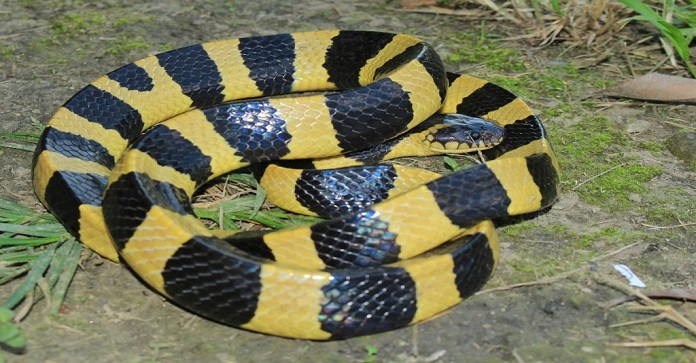
References: https://en.wikipedia.org/wiki/Banded_krait
2.3. King Cobra (Ophiophagus hannah)
The King Cobra (Ophiophagus hannah) is a large and venomous snake, renowned as one of the most dangerous snake species in the world. Here is some detailed information about this species:
Appearance: The King Cobra is one of the largest snake species, capable of reaching a length of 3–5 meters (10–16 feet) and, in some cases, up to 6 meters. They have a powerful, flattened body and a wide head with a distinctive V-shaped hood. The color of a King Cobra is typically brown or brownish-yellow, and it may have various light and dark patterns or stripes on its body.
Distribution and Habitat: King Cobras are distributed throughout Southeast Asia, including India, China, Indochina, Malaysia, Indonesia, and neighboring countries. They prefer to live in diverse environments such as thick forests, grasslands, fields, and areas near water.
Behavioral Characteristics: King Cobras are a terrestrial and arboreal snake, with good tree-climbing abilities. They are usually active at night and have a solitary habit. King Cobras possess a powerful venom that can be fatal to humans if bitten. This is a very aggressive snake, and when it feels threatened, it will raise its body, lift its head, and hiss, striking a pose similar to a cobra to threaten its enemies.
Diet: King Cobras are carnivores and primarily prey on other snakes, including venomous ones. They may also hunt other animals like rodents, birds, frogs, and even other small animals.
Reproduction: King Cobras are egg-layers. The female will lay 20–50 eggs in a nest made of leaves or hay. The eggs will hatch after about 60–80 days, and the hatchlings will be 45–55 centimeters (18–22 inches) long.
The King Cobra is considered one of the most dangerous snake species due to its potent venom and aggressive nature. Although they pose a danger to humans, King Cobras play an important role in ecological balance by controlling the population of other snakes and rodents.
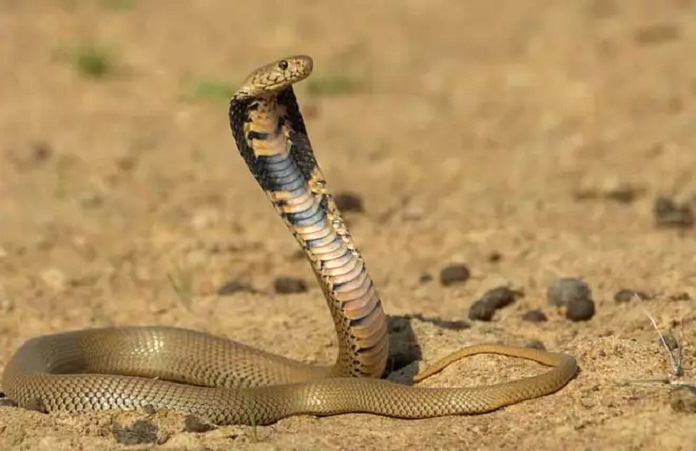
References: https://en.wikipedia.org/wiki/King_cobra
2.4. Golden Lancehead Viper (Bothrops insularis)
The Golden Lancehead Viper (Bothrops insularis), also known as the yellow lancehead viper, is a venomous snake belonging to the family Viperidae. This species is endemic to Queimada Grande Island in Brazil. Here is some information about this species:
Appearance: The Golden Lancehead Viper has an average length of 70–90 cm (28–35 inches), with some larger individuals reaching up to 110 cm. They have a stout body and a large head. A characteristic of this species is the distinctive green color on its head and neck, with a bright yellow stripe running along its body. The rest of its body is a brown or gray color.
Distribution and Habitat: The Golden Lancehead Viper is only found on Queimada Grande Island, a small island located about 35 km off the coast of Brazil. This is a volcanic island, and Golden Lancehead Vipers like to live in tropical rainforests, specifically in dense and rocky areas.
Characteristics and Behavior: The Golden Lancehead Viper is a nocturnal snake and is mainly active at night. They typically lie hidden in tall grass or rock crevices during the day. Golden Lancehead Vipers have a powerful venom system, with long fangs at the front of their upper jaw. They hunt by waiting and attacking their prey by surprise when it gets close. They mainly eat rodents, birds, and lizards.
Conservation Status: The Golden Lancehead Viper is one of the rarest and most critically endangered snakes. Its habitat is limited to Queimada Grande Island, combined with illegal hunting and consumption. As a result, this species is listed as “Endangered” on the IUCN Red List.
Protecting the habitat and controlling human activity on Queimada Grande Island are very important for protecting the Golden Lancehead Viper and ensuring the future survival of this species.
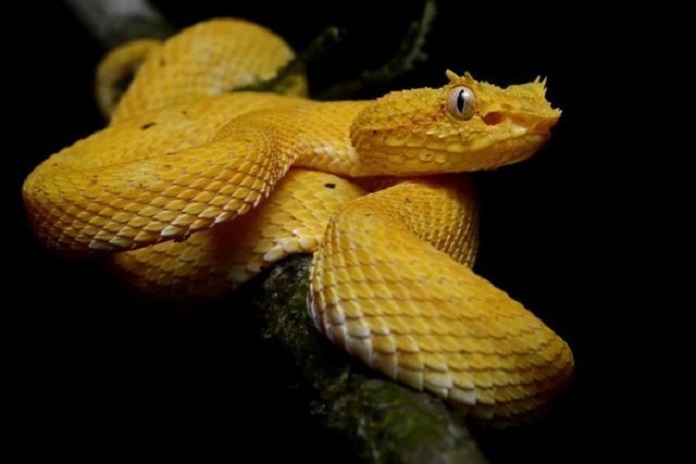
References: https://en.wikipedia.org/wiki/Golden_lancehead
2.5. Eastern Tiger Snake (Pseudonaja)
The Eastern Tiger Snake (Pseudonaja) is a genus of snakes in the family Elapidae, distributed mainly in Asia and Australia. Here is some information about this species:
Appearance: The Eastern Tiger Snake is a medium-to-large snake, with a length of 1–2 m (3–6.5 ft). Their color is typically brownish-yellow to black, and they may have different patterns or markings on their bodies. Some species have lighter colors and have yellow, orange, or white stripes or spots.
Distribution and Habitat: The Eastern Tiger Snake is widely distributed throughout Asia and Australia, including countries like India, China, Vietnam, Malaysia, Indonesia, Papua New Guinea, and Australia. They like to live in diverse environments such as forests, fields, grasslands, and areas near water.
Behavior: The Eastern Tiger Snake is a venomous snake with potent venom. They have a fixed front jaw and are dangerous to humans. Eastern Tiger Snakes are typically active at night and have a solitary habit. They hunt by lying in wait and attacking their prey by surprise when it gets close. They mainly eat small animals like mice, rabbits, birds, and lizards.
Reproduction: Eastern Tiger Snakes are egg-layers. The female lays 5–20 eggs in a natural nest. The eggs are incubated for a period of time depending on the environmental temperature and then hatch into young snakes.
The Eastern Tiger Snake is a diverse and important group of snakes in the ecosystem. Some species have high medical and biological research value due to their ability to produce compounds with biological effects. However, due to their venomous and dangerous nature, it is important to be cautious when in contact with Eastern Tiger Snakes and to follow appropriate safety measures.

References: https://en.wikipedia.org/wiki/Tiger_snake
2.6. Mexican Garter Snake (Thamnophis eques)
The Mexican Garter Snake (Thamnophis eques) is a species of snake belonging to the family Colubridae and is endemic to Mexico. Here is some detailed information about this species:
Appearance: The Mexican Garter Snake has an average size of 40–80 cm (16–31 inches), depending on the individual and gender. They have slender and flattened bodies. The color of the Mexican Garter Snake is a bright yellow or orange-yellow, and it may have dark stripes that run along its body. There are several different color variations within this species.
Distribution and Habitat: The Mexican Garter Snake is endemic to Mexico and is distributed mainly in southern Mexico and the border region with the United States. They like to live in diverse environments such as fields, savannas, forests, grasslands, and areas near rivers and ponds.
Habits and Diet: The Mexican Garter Snake is a non-venomous snake and is generally not a danger to humans. They hunt small animals like frogs, mice, worms, and insects. The Mexican Garter Snake likes to hide in the grass or under natural materials like rocks or wood.
Reproduction: The Mexican Garter Snake is an egg-laying species. The female lays 6–16 eggs in the spring or summer. The eggs are laid in a moist environment like grass or soil and hatch into young snakes after a few weeks to a few months.
The Mexican Garter Snake is a beautiful and common snake in captive environments. They are ecologically important in controlling the overpopulation of insects and play a role as part of the food chain.
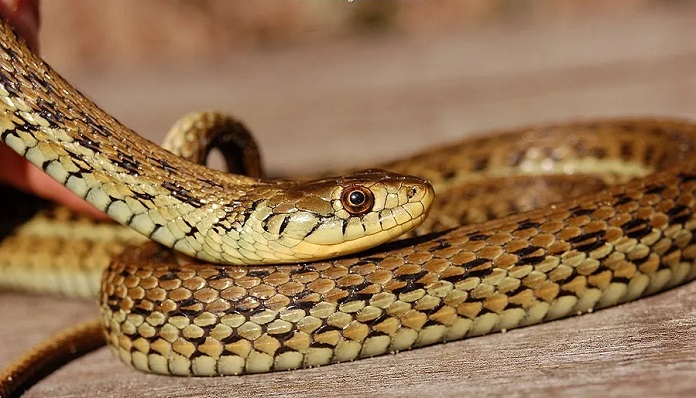
References: https://en.wikipedia.org/wiki/Mexican_garter_snake
2.7. Inland Taipan (Oxyuranus microlepidotus)
The Inland Taipan (Oxyuranus microlepidotus) is a venomous snake belonging to the family Elapidae, distributed mainly in the inland regions of Australia. Here is some information about this species:
Appearance: The Inland Taipan is one of Australia’s largest and most venomous snakes. They have an average length of 1.8–2.5 meters (6–8 feet), but can reach up to 3.3 meters in some cases. Inland Taipans have a slender body and a long tail. Their color is usually yellow, brownish-yellow, grayish-brown, or blackish-brown, with a light pattern running along their body.
Distribution and Habitat: Inland Taipans are found mainly in the inland regions of Australia, in areas such as eastern Queensland, northern and central Northern Territory, and western Australia. They like to live in diverse environments such as fields, grasslands, savannas, and open forested areas.
Behavioral Characteristics: The Inland Taipan is a venomous snake with very potent venom. Its venom contains powerful toxins that damage the nervous system and can cause death quickly if not treated in time. They have a fixed front jaw and long fangs at the front of their upper jaw. Inland Taipans are typically very shy and avoid contact with humans. They hunt by wandering and attacking fiercely when they find prey.
Conservation Status: The Inland Taipan is not on the IUCN’s special conservation list. Although they are a venomous snake and pose a risk to humans, encountering an Inland Taipan in the wild is quite rare.
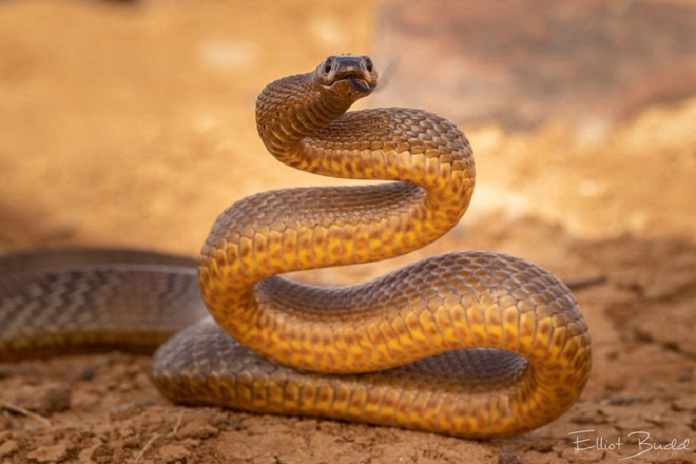
References: https://en.wikipedia.org/wiki/Inland_taipan
2.8. Red-Necked Keelback (Rhabdophis subminiatus)
The Red-Necked Keelback (Rhabdophis subminiatus) is a common snake in Southeast Asia, including Vietnam, Cambodia, Laos, Thailand, and parts of China and Myanmar. Here is some information about this species:
Appearance: The Red-Necked Keelback is a medium-sized snake, with a length typically from 50–80 cm (20–31 inches). They have a slender body and a long tail. Their color is often a golden-yellow, brown, or brownish-black with a red patch on the back of the neck. This snake can display a red hood when it is agitated or threatened.
Distribution and Habitat: The Red-Necked Keelback lives in diverse environments such as forests, fields, grasslands, and areas near rivers and lakes. They like to live near areas with lots of bushes, tall grass, and places with many food sources, such as potential prey like frogs, mice, and other small animals.
Characteristics and Behavior: The Red-Necked Keelback is a moderately dangerous snake to humans. This species has a special defense mechanism called a “two-faced animal.” When agitated or threatened, they can display a striking orange or red hood on the back of their neck, along with a contraction and display of their neck, to warn and intimidate their enemies.
Reproduction: The Red-Necked Keelback is an egg-laying species. The female lays 6–12 eggs in a natural nest. The eggs are incubated for a period of time depending on the environmental conditions, and then they hatch into young snakes.
The Red-Necked Keelback is considered a significant danger to humans. Therefore, you should be cautious when in contact with them or avoid them altogether. When you encounter a snake of any kind, you should keep a safe distance and avoid agitating or provoking them.
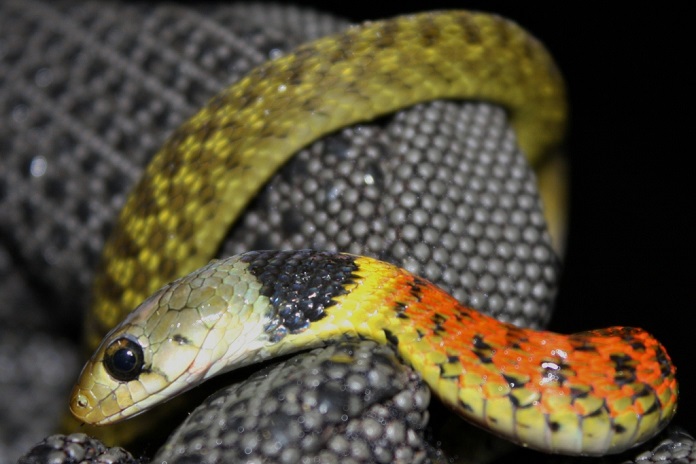
References: https://en.wikipedia.org/wiki/Rhabdophis_subminiatus
3. FAQs
1. Are yellow snakes venomous?
Some yellow snakes are venomous, such as the Yellow-Bellied Sea Snake and the Mangrove Pit Viper. However, many yellow snakes, like the Albino Ball Python and Yellow Rat Snake, are non-venomous and harmless to humans. Always research the specific species before approaching.
2. Why are some snakes yellow?
Yellow coloration in snakes can be due to genetic traits, environmental adaptation, or selective breeding. In the wild, yellow may serve as camouflage among dry leaves or grass, while in captivity, it is often the result of morphs or albinism.
3. Can yellow snakes be kept as pets?
Yes, several yellow snakes make excellent pets, especially species like the Albino Corn Snake, Albino Ball Python, and Yellow Rat Snake. They are usually docile, easy to care for, and widely available in the pet trade.
4. What are some popular yellow snake species?
Popular yellow snake species include the Albino Ball Python, Yellow Rat Snake, Banana Python, Yellow Anaconda, and Green Tree Python (which can appear yellow in juvenile stages). Each species varies in size, temperament, and habitat needs.
Know All Animals has shared information with you to answer the question, “What are yellow snakes?” and has provided a list of some of the most common Yellow Snake species today. We hope this article has given you more insight into these vibrant snakes, so you can learn how to identify them and avoid any danger they may pose.

